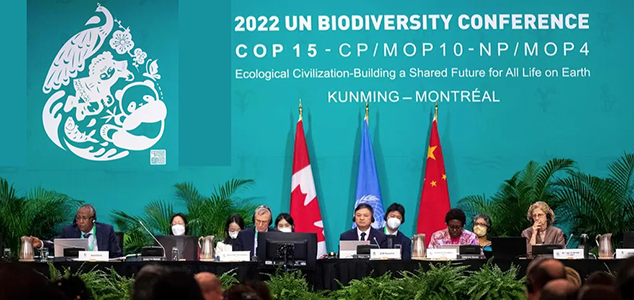Roughly 190 nations, aiming to halt a dangerous decline in biodiversity, agreed to preserve 30 percent of the planet’s land and seas. The United States is not officially a participant.
||| FROM THE NEW YORK TIMES |||
MONTREAL, Quebec — Roughly 190 countries early on Monday approved a sweeping United Nations agreement to protect 30 percent of the planet’s land and oceans by 2030 and to take a slew of other measures against biodiversity loss, a mounting under-the-radar crisis that, if left unchecked, jeopardizes the planet’s food and water supplies as well as the existence of untold species around the world.
The agreement comes as biodiversity is declining worldwide at rates never seen before in human history. Researchers have projected that a million plants and animals are at risk of extinction, many within decades. The last extinction event of that magnitude was the one that killed off the dinosaurs 65 million years ago.
While many scientists and activists had pushed for even stronger measures, the deal, which includes monitoring mechanisms that previous agreements had lacked, clearly signals increasing momentum around the issue.
“This is a huge moment for nature,” Brian O’Donnell, director of the Campaign for Nature, a coalition of groups pushing for protections, said about the agreement. “This is a scale of conservation that we haven’t seen ever attempted before.”
Overall, the deal lays out a suite of 23 environmental targets. The most prominent, known as 30×30, would place 30 percent of land and sea under protection. Currently, about 17 percent of the planet’s land and roughly 8 percent of its oceans are protected, with restrictions on activities like fishing, farming and mining.
The United States is just one of two countries in the world that are not party to the Convention on Biological Diversity, largely because Republicans, who are typically opposed to joining treaties, have blocked United States membership. That means the American delegation was required to participate from the sidelines. (The only other country that has not joined the treaty is the Holy See.)
- Did you know you can share 10 gift articles a month, even with nonsubscribers?
President Biden has signed an executive order that would similarly place 30 percent of United States land and waters under protection, but any legislative efforts to support that goal are expected to face strong opposition when Republicans take control of the House in January.
Countries also agreed to manage the remaining 70 percent of the planet to avoid losing areas of high importance to biodiversity and to ensure that big businesses disclose biodiversity risks and impacts from their operations.
Now, the question is whether the deal’s lofty targets will be realized.
A previous 10-year agreement failed to fully achieve a single target at the global level, according to the body that oversees the Convention on Biological Diversity, the United Nations treaty that underpins the old agreement and the new one reached here on Monday. But negotiators said they had learned from their mistakes, and the new pact includes provisions to make targets measurable and to monitor countries’ progress.
While there are multiple causes of biodiversity loss, humans are behind each one. On land, the biggest driver is agriculture. At sea, it’s overfishing. Other factors include hunting, mining, logging, climate change, pollution and invasive species.
The agreement aims to address these drivers. Target 17, for example, commits to reducing the overall risk from pesticides and highly toxic chemicals by at least half, while also addressing fertilizer runoff.
Conservation groups had pushed for stronger measures related to extinctions and wildlife populations.
Anne Larigauderie, an ecologist and the executive secretary of the intergovernmental scientific platform on biodiversity, known as IPBES, regretted that omission but praised the overall agreement as ambitious and quantified.
“It’s a compromise, but it’s not a bad one,” Dr. Larigauderie said.
The European Union had sought more forceful conservation targets. Indonesia wanted more leeway on how it used nature.
An outsize amount of the world’s biodiversity lives in countries of the global south. But these nations often lack the hefty financial resources needed to restore ecosystems, to reform harmful agriculture, aquaculture, fisheries and forestry practices; and to conserve threatened species.
Developing countries pushed hard for more funding, with representatives of dozens of countries from Latin American, Africa and Southeast Asia walking out of meetings on Wednesday in protest that they weren’t being heard.
The Democratic Republic of Congo expressed fierce opposition and held up final approval into the early hours of Monday morning. When the president of the talks proceeded over the Congolese objections, delegates from several African spoke out in protest.
The deal reached on Monday would roughly double overall biodiversity financing to $200 billion a year from all sources: governments, the private sector and philanthropy. It earmarks up to $30 billion per year to flow to poor countries from wealthy nations. The financial commitments are not legally binding.
Representatives of developing countries said that money should not be seen as charity.
**If you are reading theOrcasonian for free, thank your fellow islanders. If you would like to support theOrcasonian CLICK HERE to set your modestly-priced, voluntary subscription. Otherwise, no worries; we’re happy to share with you.**








“The United States is just one of two countries in the world that are not party to the Convention on Biological Diversity, largely because Republicans, who are typically opposed to joining treaties, have blocked United States membership. That means the American delegation was required to participate from the sidelines. (The only other country that has not joined the treaty is the Holy See.)”
This is literally about survival on this planet. That the US refuses to participate with EVERY other (real) country tells you all you need to know about the long term survival of this country. I am saddened, ashamed and disgusted. But not actually surprised.
The Pacific States should repudiate this repugnant national position and issue a joint statement aligning us with the rest of the citizens of this planet.